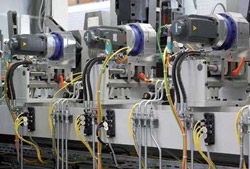
Posted to News on 24th Nov 2015, 14:05
Benefits of 'bottom up' installation for automation systems
The design and installation of automation systems is often approached with a 'top down' perspective, from the control platform down to the sensors and actuators. But Murrelektronik has adopted a 'bottom up' philosophy that it says is more cost-effective and efficient.

The 'top down' methodology is inverse to the way the mechanical build is approached, which is normally from the bottom up. For example, first the machine base is positioned, the machine's framework is then assembled and the working parts of the machine - including the end devices - are assembled and mounted.
This method, used by many control system installers, can prove to be expensive and wasteful in terms of resources. Device connectivity, the positioning of I/O modules, cable management and containment are often the last tasks to be performed, often without sufficient planning. This can lead to compromised cable routes and containment options, resulting in lost time and expensive 'workarounds.'
Cables and connectivity
In short, the end devices determine the connectivity requirements at each device. The number and type of input and output devices will determine the I/O required to transmit signals to and from the control platform; and the position and type of each device, together with their grouping, determine the variant and location of each I/O module. This information can then be translated into the connector and cable types, the cable routes back to the control panel, and any containment that may be required. Special attention needs to be paid to the cable variants, depending on whether the cable is fixed or running through moving parts of the machine, such as drag chains and/or robots.
Other considerations, such as containment, cable management and fixings, also need to be factored in. Once the cables have reached the control panel, cable entry and connectivity to the panel needs to be specified. This will depend on a range of factors, including the number of cables, if cables have pre-moulded connectors, and whether containment (for example, a flexible conduit) will be brought up to the control panel.
Effective equipment selection
Inside the control panel the PLC or PC is often specified by the end user, or is chosen by the machine builder, to suit the application or as a preference. Most of the other equipment is chosen by the controls engineer. Equipment needs to be selected based on the connected devices. This will include any grounding required for incoming cables (for example, servo cables). The 24V DC power supplies need to be sized and selected. There may be a need for PSU redundancy and a suitable method of achieving this may need to be decided. Suitable 24V DC circuit protection and distribution has to be established, and buffering of some of the 24VDC equipment may be required for devices such as HMIs and PCs to allow for a controlled shut down, and EMC filtration may be required on the incoming supply to the PSU.
The earlier in the machine build cycle that this approach is adopted, the better. This will allow for a planned approach to the installation of the automation system and stop the last-minute panic that sometimes results from poor pre-planning. It will save time and money in the installation process, ultimately leading to competitive pricing for the machine and more profit for the builder.
Follow the link for more information about products and systems from Murrelektronik.
Want the latest machine building news straight to your inbox? Become a MachineBuilding member for free today >>
5 Albion Street, Pendlebury Industrial Estate
Swinton
M27 4FG
UNITED KINGDOM
+44 (0)161 728 3133

















